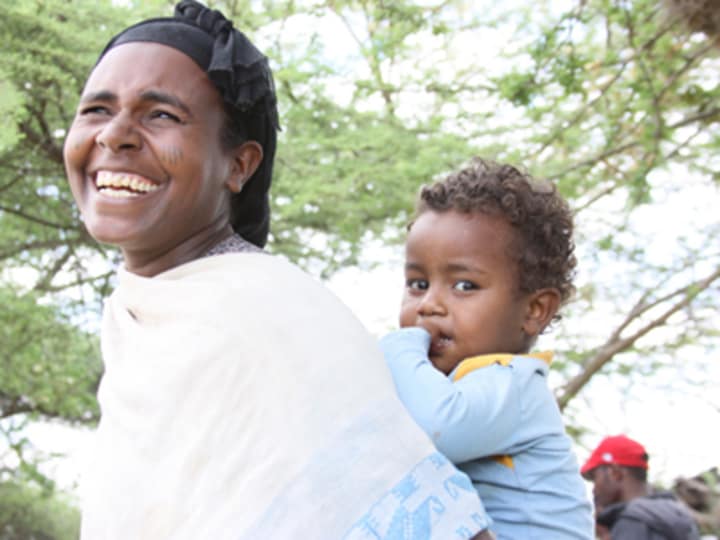
A year after former U.S. Secretary of State Hillary Clinton launched “Saving Mothers, Giving Life,” U.S. and African health leaders believe the inter-agency public-private partnership has proven that surgical and other interventions once thought to be too difficult and expensive can dramatically reduce maternal and infant death in high-mortality settings.
Nearly a third fewer mothers died and the percentage of births occurring at health facilities rose drastically in eight “proof-of-concept” districts in Zambia and Uganda, according to a Centers for Disease Control evaluation of the five-year initiative.
The partnership draws on the CDC’s data-gathering and analysis expertise to ground its programs in substantial quantitative evidence. “There is, perhaps, no better model for us,” U.S. Agency for International Development Administrator Rajiv Shah said on Thursday.
But now that “proof-of concept” appears to exist, the question remains: Can the successful model find its way to the center of integrated U.S. global health policy and not on to a long list of one-off development initiatives that struggle to go to scale?
Devex spoke with Robert Clay, deputy assistant administrator in USAID’s Bureau for Global Health, to learn how “Saving Mothers, Giving Life” overcame skepticism to save lives and what the future looks like for maternal and child health programming at the agency.
You spoke a lot about the role of learning and adapting this program to what you learned as you went along in this first year. What specific mechanisms did you put in place to capture learning and then distribute those lessons across a multiple agency effort? What have been the challenges involved in doing that?
Data’s not good unless you actually use it for decisions. This afternoon we’re having a meeting of the leadership council, which is the heads of all the different agencies, and we’re going to be reviewing all that information and then coming up with … what does this tell us about the next steps? Should we be reducing the amount of resources we put into demand generation, for example? … We’re finding in some places, just having the facilities equipped and with good trained staff, the word is getting out from mothers who are having a good experience. So we don’t need to create all this awareness that we’ve changed, because they’re [talking among] themselves. We can actually lessen our attention on that and focus on other areas. So it’s that kind of feedback that’s very important as we move forward.
Most of the learning in development is in the “grey literature” … We also want to focus on getting it in peer-reviewed journals, so that it has that credibility. A lot of information people have in their heads or on scratches of paper, but to really get it in a format that it can be shared and then people can actually learn is really important.
It seems like USAID typically appropriates program funding for multiple years in ways that can make it difficult to make rapid adjustments. How were you able to learn as you went and make changes to the model along the way? Was there anything unique in the way this program was built to make it easier to adapt to those lessons quickly?
I think in some ways it’s a blessing and a curse. We had this year to really demonstrate impact, which made it the big push. We were doing lots of things, high-level activity with the idea that we needed to really demonstrate after that year that we were having some sort of success or not. Most programs don’t have that kind of constraint — that big push up front. That was critical in this area where there was a lot of skepticism about whether this was going to work or not. So we needed to really have that evidence to be able to garner that support. But it also means that we now have to expand our horizon. We have to use that for the longer term purpose. Just doing it in this short time period, it would be a flash in the pan and we wouldn’t have any long-term effects.
This initiative was born out of very high-level buy-in and leadership, specifically at a leadership position that has now changed. Is the success you’ve been able to demonstrate enough to ensure this program will be able to continue and expand? Do you still have the high-level buy-in that you need, or is that a challenge for this initiative going forward?
[U.S.] Secretary [of State John] Kerry is very supportive of global health in general and also of this program … You have to understand what you need at various times in your program’s cycle. It was very critical at the beginning that we have high-level visibility identified to get partners to join, like Merck and others … to really establish the framework … That’s probably less important now, because … we have results, so the data can be part of our advocacy tool. We also have groups like Every Mother Counts who can take this and then really use it to be the advocates. What we’re hoping also … is to have the country-level officials … the champions that need to be empowered. Because if we’re really going to have an impact it’s not the global level, it’s really … countries sharing what they’re doing with each other and [saying], well if Zambia did it, why can’t Malawi do it? Then they start to ask questions: How did you do it? What were the issues? That exchange back and forth. So the champions at the country level through the leadership is really going to be fundamental for this to be expanded…That’s where our focus is — not high-level anymore, but much more at the country level.
New initiatives put new requirements of energy and time on people at the country level. At USAID there has been an ongoing dialogue about the value of new initiatives and some fatigue over new initiatives being announced periodically. This initiative has been successful in its first year. How were you able to bring USAID staff on board at the mission level to really buy into this from the outset?
We have fifty years of work in global health. We’ve been working on child survival since the beginning, maternal health more like 25 years. This is not something that’s coming from left field. This is core to what we’re trying to do in global health at USAID. It does represent an increased intensity, and I think staff welcomed that, in the sense that they saw this as an opportunity to really make a difference.
Whether all missions would want to have the intensity, I think probably not. There are competing demands in terms of country resources … but we’re fortunate that both Uganda and Zambia agreed to do this, and I think they saw it as an opportunity, because they’d been trying to get this program running for a long time, and they’ve missed that political element.
I was in Zambia in 1998 for five years, and we faced the same thing on HIV/AIDS… we had the world’s worst epidemic happening in our country and the global community didn’t care … they didn’t have the focus and attention. We were struggling to get people to try to address this when people were dying all over. The world acknowledged that … and we had The Global Fund. We had PEPFAR. I think this field was in a similar situation. They saw women dying. They saw the interventions were there, but we just didn’t have that support. So they saw this as an opportunity and stepped up. Some countries … we’re discussing with them that they’re seeing this as well and they’re going to be part of the program. Others will need more convincing as we go forward … the real world is that there are a lot of demands on people’s time.
What is the one biggest obstacle to scaling this up and expanding it at this point?
In general it’s always political. If you get the President … or key government officials engaged, then you open so many doors. It’s that level that’s important. You can always say resources, but I think there’s a lot of creative ways in which we can address the resource constraints that we need to pursue. So, I wouldn’t put that as the number one barrier.
Read more on U.S. aid reform online, and subscribe to The Development Newswire to receive top international development headlines from the world’s leading donors, news sources and opinion leaders — emailed to you FREE every business day.




